Karl Sammut
Towards Bio-inspired Heuristically Accelerated Reinforcement Learning for Adaptive Underwater Multi-Agents Behaviour
Feb 10, 2025

Abstract:This paper describes the problem of coordination of an autonomous Multi-Agent System which aims to solve the coverage planning problem in a complex environment. The considered applications are the detection and identification of objects of interest while covering an area. These tasks, which are highly relevant for space applications, are also of interest among various domains including the underwater context, which is the focus of this study. In this context, coverage planning is traditionally modelled as a Markov Decision Process where a coordinated MAS, a swarm of heterogeneous autonomous underwater vehicles, is required to survey an area and search for objects. This MDP is associated with several challenges: environment uncertainties, communication constraints, and an ensemble of hazards, including time-varying and unpredictable changes in the underwater environment. MARL algorithms can solve highly non-linear problems using deep neural networks and display great scalability against an increased number of agents. Nevertheless, most of the current results in the underwater domain are limited to simulation due to the high learning time of MARL algorithms. For this reason, a novel strategy is introduced to accelerate this convergence rate by incorporating biologically inspired heuristics to guide the policy during training. The PSO method, which is inspired by the behaviour of a group of animals, is selected as a heuristic. It allows the policy to explore the highest quality regions of the action and state spaces, from the beginning of the training, optimizing the exploration/exploitation trade-off. The resulting agent requires fewer interactions to reach optimal performance. The method is applied to the MSAC algorithm and evaluated for a 2D covering area mission in a continuous control environment.
Wake-Informed 3D Path Planning for Autonomous Underwater Vehicles Using A* and Neural Network Approximations
Feb 04, 2025Abstract:Autonomous Underwater Vehicles (AUVs) encounter significant energy, control and navigation challenges in complex underwater environments, particularly during close-proximity operations, such as launch and recovery (LAR), where fluid interactions and wake effects present additional navigational and energy challenges. Traditional path planning methods fail to incorporate these detailed wake structures, resulting in increased energy consumption, reduced control stability, and heightened safety risks. This paper presents a novel wake-informed, 3D path planning approach that fully integrates localized wake effects and global currents into the planning algorithm. Two variants of the A* algorithm - a current-informed planner and a wake-informed planner - are created to assess its validity and two neural network models are then trained to approximate these planners for real-time applications. Both the A* planners and NN models are evaluated using important metrics such as energy expenditure, path length, and encounters with high-velocity and turbulent regions. The results demonstrate a wake-informed A* planner consistently achieves the lowest energy expenditure and minimizes encounters with high-velocity regions, reducing energy consumption by up to 11.3%. The neural network models are observed to offer computational speedup of 6 orders of magnitude, but exhibit 4.51 - 19.79% higher energy expenditures and 9.81 - 24.38% less optimal paths. These findings underscore the importance of incorporating detailed wake structures into traditional path planning algorithms and the benefits of neural network approximations to enhance energy efficiency and operational safety for AUVs in complex 3D domains.
A generalised novel loss function for computational fluid dynamics
Nov 26, 2024



Abstract:Computational fluid dynamics (CFD) simulations are crucial in automotive, aerospace, maritime and medical applications, but are limited by the complexity, cost and computational requirements of directly calculating the flow, often taking days of compute time. Machine-learning architectures, such as controlled generative adversarial networks (cGANs) hold significant potential in enhancing or replacing CFD investigations, due to cGANs ability to approximate the underlying data distribution of a dataset. Unlike traditional cGAN applications, where the entire image carries information, CFD data contains small regions of highly variant data, immersed in a large context of low variance that is of minimal importance. This renders most existing deep learning techniques that give equal importance to every portion of the data during training, inefficient. To mitigate this, a novel loss function is proposed called Gradient Mean Squared Error (GMSE) which automatically and dynamically identifies the regions of importance on a field-by-field basis, assigning appropriate weights according to the local variance. To assess the effectiveness of the proposed solution, three identical networks were trained; optimised with Mean Squared Error (MSE) loss, proposed GMSE loss and a dynamic variant of GMSE (DGMSE). The novel loss function resulted in faster loss convergence, correlating to reduced training time, whilst also displaying an 83.6% reduction in structural similarity error between the generated field and ground truth simulations, a 76.6% higher maximum rate of loss and an increased ability to fool a discriminator network. It is hoped that this loss function will enable accelerated machine learning within computational fluid dynamics.
Real-Time Scene Graph Generation
May 25, 2024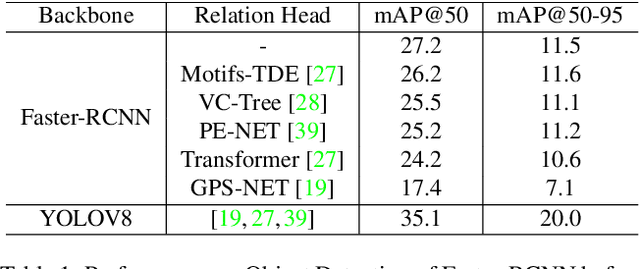



Abstract:Scene Graph Generation (SGG) can extract abstract semantic relations between entities in images as graph representations. This task holds strong promises for other downstream tasks such as the embodied cognition of an autonomous agent. However, to power such applications, SGG needs to solve the gap of real-time latency. In this work, we propose to investigate the bottlenecks of current approaches for real-time constraint applications. Then, we propose a simple yet effective implementation of a real-time SGG approach using YOLOV8 as an object detection backbone. Our implementation is the first to obtain more than 48 FPS for the task with no loss of accuracy, successfully outperforming any other lightweight approaches. Our code is freely available at https://github.com/Maelic/SGG-Benchmark.
Hybrid Navigation Acceptability and Safety
Apr 18, 2024
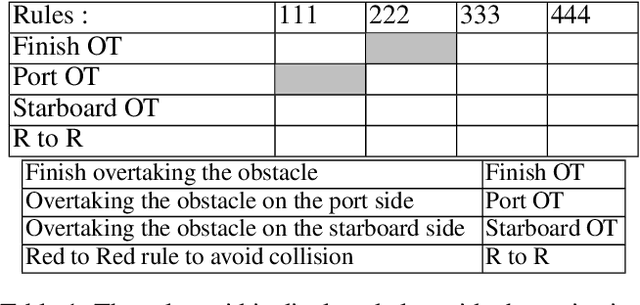


Abstract:Autonomous vessels have emerged as a prominent and accepted solution, particularly in the naval defence sector. However, achieving full autonomy for marine vessels demands the development of robust and reliable control and guidance systems that can handle various encounters with manned and unmanned vessels while operating effectively under diverse weather and sea conditions. A significant challenge in this pursuit is ensuring the autonomous vessels' compliance with the International Regulations for Preventing Collisions at Sea (COLREGs). These regulations present a formidable hurdle for the human-level understanding by autonomous systems as they were originally designed from common navigation practices created since the mid-19th century. Their ambiguous language assumes experienced sailors' interpretation and execution, and therefore demands a high-level (cognitive) understanding of language and agent intentions. These capabilities surpass the current state-of-the-art in intelligent systems. This position paper highlights the critical requirements for a trustworthy control and guidance system, exploring the complexity of adapting COLREGs for safe vessel-on-vessel encounters considering autonomous maritime technology competing and/or cooperating with manned vessels.
Sim-to-Real Transfer of Adaptive Control Parameters for AUV Stabilization under Current Disturbance
Oct 17, 2023Abstract:Learning-based adaptive control methods hold the premise of enabling autonomous agents to reduce the effect of process variations with minimal human intervention. However, its application to autonomous underwater vehicles (AUVs) has so far been restricted due to 1) unknown dynamics under the form of sea current disturbance that we can not model properly nor measure due to limited sensor capability and 2) the nonlinearity of AUVs tasks where the controller response at some operating points must be overly conservative in order to satisfy the specification at other operating points. Deep Reinforcement Learning (DRL) can alleviates these limitations by training general-purpose neural network policies, but applications of DRL algorithms to AUVs have been restricted to simulated environments, due to their inherent high sample complexity and distribution shift problem. This paper presents a novel approach, merging the Maximum Entropy Deep Reinforcement Learning framework with a classic model-based control architecture, to formulate an adaptive controller. Within this framework, we introduce a Sim-to-Real transfer strategy comprising the following components: a bio-inspired experience replay mechanism, an enhanced domain randomisation technique, and an evaluation protocol executed on a physical platform. Our experimental assessments demonstrate that this method effectively learns proficient policies from suboptimal simulated models of the AUV, resulting in control performance 3 times higher when transferred to a real-world vehicle, compared to its model-based nonadaptive but optimal counterpart.
Response Component Analysis for Sea State Estimation Using Artificial Neural Networks and Vessel Response Spectral Data
May 05, 2022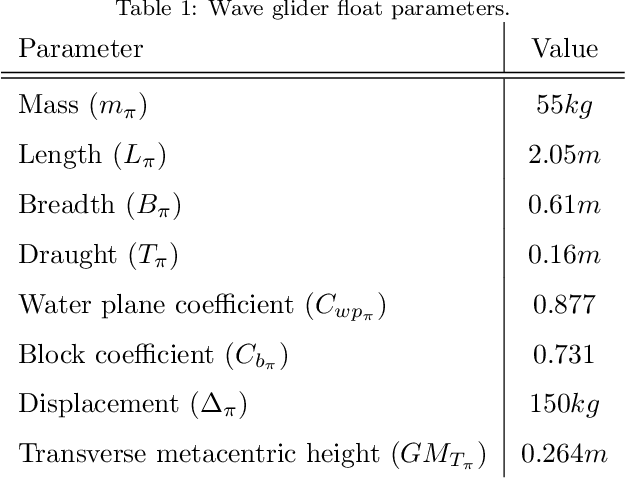
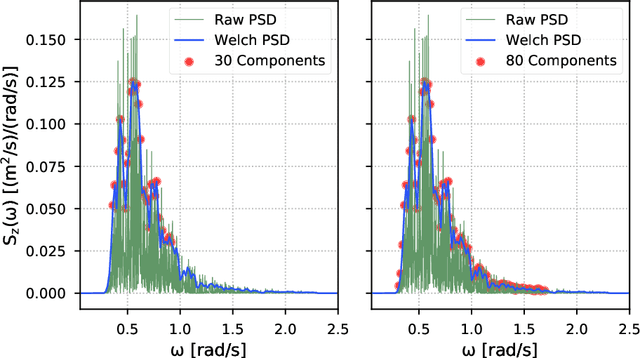
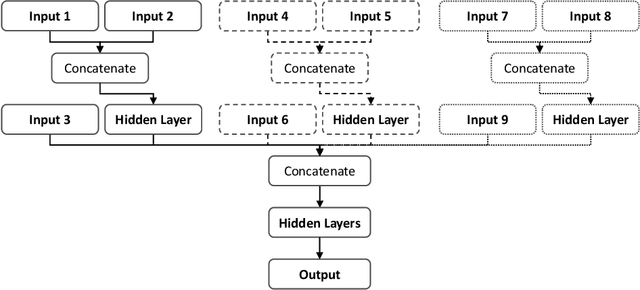
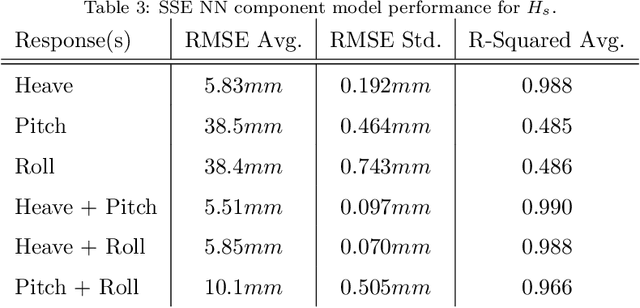
Abstract:The use of the `ship as a wave buoy analogy' (SAWB) provides a novel means to estimate sea states, where relationships are established between causal wave properties and vessel motion response information. This study focuses on a model-free machine learning approach to SAWB-based sea state estimation (SSE), using neural networks (NNs) to map vessel response spectral data to statistical wave properties. Results showed a strong correlation between heave responses and significant wave height estimates, whilst the accuracy of mean wave period and wave heading predictions were observed to improve considerably when data from multiple vessel degrees of freedom (DOFs) was utilized. Overall, 3-DOF (heave, pitch and roll) NNs for SSE were shown to perform well when compared to existing SSE approaches that use similar simulation setups. Given the information-dense statistical representation of vessel motion responses in spectral form, as well as the ability of NNs to effectively model complex relationships between variables, the designed SSE method shows promise for future adaptation to mobile SSE systems using the SAWB approach.
Learning-based vs Model-free Adaptive Control of a MAV under Wind Gust
Jan 29, 2021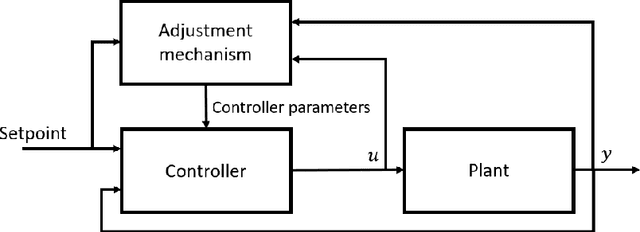

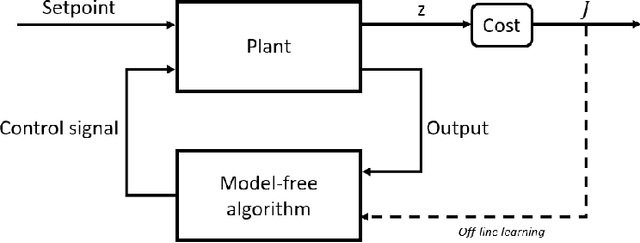
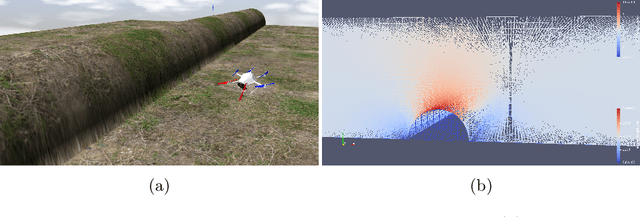
Abstract:Navigation problems under unknown varying conditions are among the most important and well-studied problems in the control field. Classic model-based adaptive control methods can be applied only when a convenient model of the plant or environment is provided. Recent model-free adaptive control methods aim at removing this dependency by learning the physical characteristics of the plant and/or process directly from sensor feedback. Although there have been prior attempts at improving these techniques, it remains an open question as to whether it is possible to cope with real-world uncertainties in a control system that is fully based on either paradigm. We propose a conceptually simple learning-based approach composed of a full state feedback controller, tuned robustly by a deep reinforcement learning framework based on the Soft Actor-Critic algorithm. We compare it, in realistic simulations, to a model-free controller that uses the same deep reinforcement learning framework for the control of a micro aerial vehicle under wind gust. The results indicate the great potential of learning-based adaptive control methods in modern dynamical systems.
A Comprehensive Review of Shepherding as a Bio-inspired Swarm-Robotics Guidance Approach
Dec 18, 2019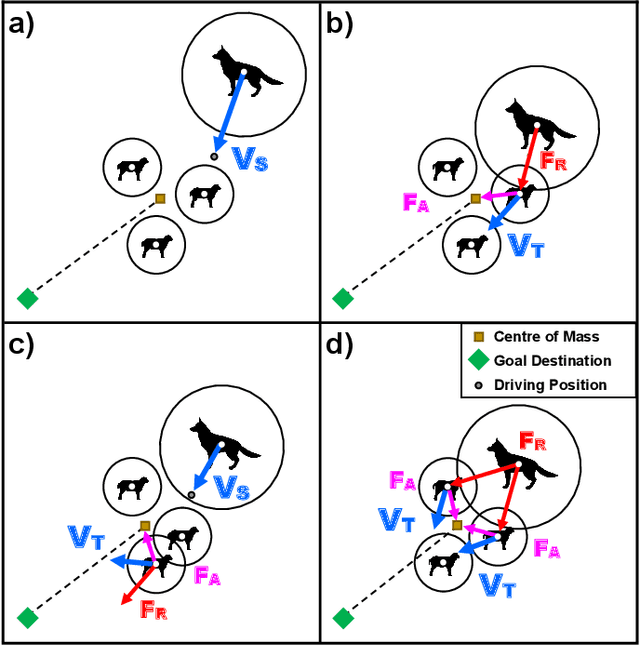
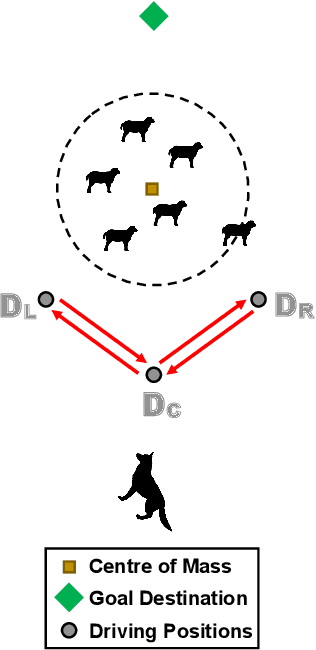
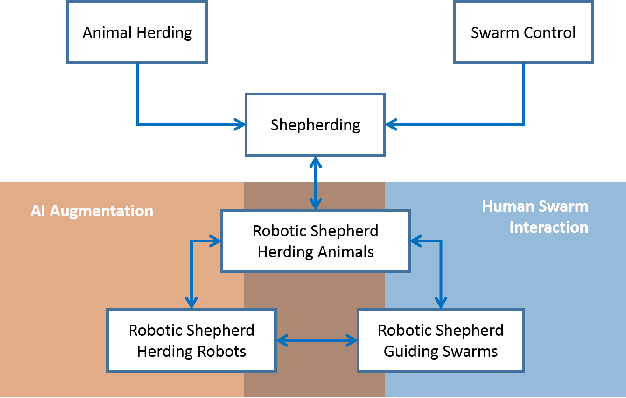
Abstract:The simultaneous control of multiple coordinated robotic agents represents an elaborate problem. If solved, however, the interaction between the agents can lead to solutions to sophisticated problems. The concept of swarming, inspired by nature, can be described as the emergence of complex system-level behaviors from the interactions of relatively elementary agents. Due to the effectiveness of solutions found in nature, bio-inspired swarming-based control techniques are receiving a lot of attention in robotics. One method, known as swarm shepherding, is founded on the sheep herding behavior exhibited by sheepdogs, where a swarm of relatively simple agents are governed by a shepherd (or shepherds) which is responsible for high-level guidance and planning. Many studies have been conducted on shepherding as a control technique, ranging from the replication of sheep herding via simulation, to the control of uninhabited vehicles and robots for a variety of applications. We present a comprehensive review of the literature on swarm shepherding to reveal the advantages and potential of the approach to be applied to a plethora of robotic systems in the future.
A Hierarchal Planning Framework for AUV Mission Management in a Spatio-Temporal Varying Ocean
Nov 20, 2017Abstract:The purpose of this paper is to provide a hierarchical dynamic mission planning framework for a single autonomous underwater vehicle (AUV) to accomplish task-assign process in a limited time interval while operating in an uncertain undersea environment, where spatio-temporal variability of the operating field is taken into account. To this end, a high level reactive mission planner and a low level motion planning system are constructed. The high level system is responsible for task priority assignment and guiding the vehicle toward a target of interest considering on-time termination of the mission. The lower layer is in charge of generating optimal trajectories based on sequence of tasks and dynamicity of operating terrain. The mission planner is able to reactively re-arrange the tasks based on mission/terrain updates while the low level planner is capable of coping unexpected changes of the terrain by correcting the old path and re-generating a new trajectory. As a result, the vehicle is able to undertake the maximum number of tasks with certain degree of maneuverability having situational awareness of the operating field. The computational engine of the mentioned framework is based on the biogeography based optimization (BBO) algorithm that is capable of providing efficient solutions. To evaluate the performance of the proposed framework, firstly, a realistic model of undersea environment is provided based on realistic map data, and then several scenarios, treated as real experiments, are designed through the simulation study. Additionally, to show the robustness and reliability of the framework, Monte-Carlo simulation is carried out and statistical analysis is performed. The results of simulations indicate the significant potential of the two-level hierarchical mission planning system in mission success and its applicability for real-time implementation.
 Add to Chrome
Add to Chrome Add to Firefox
Add to Firefox Add to Edge
Add to Edge